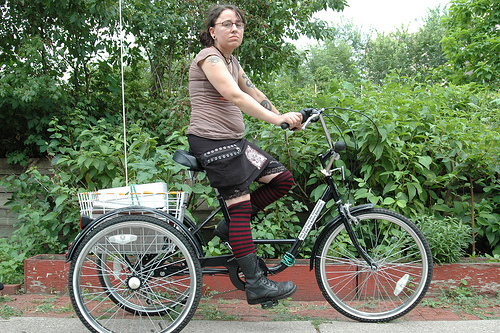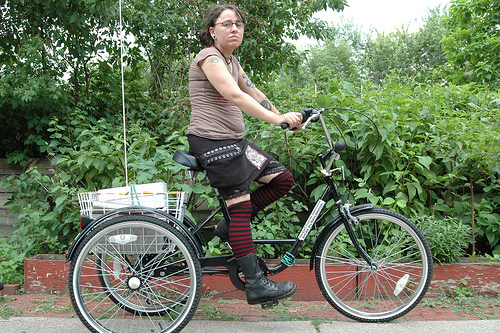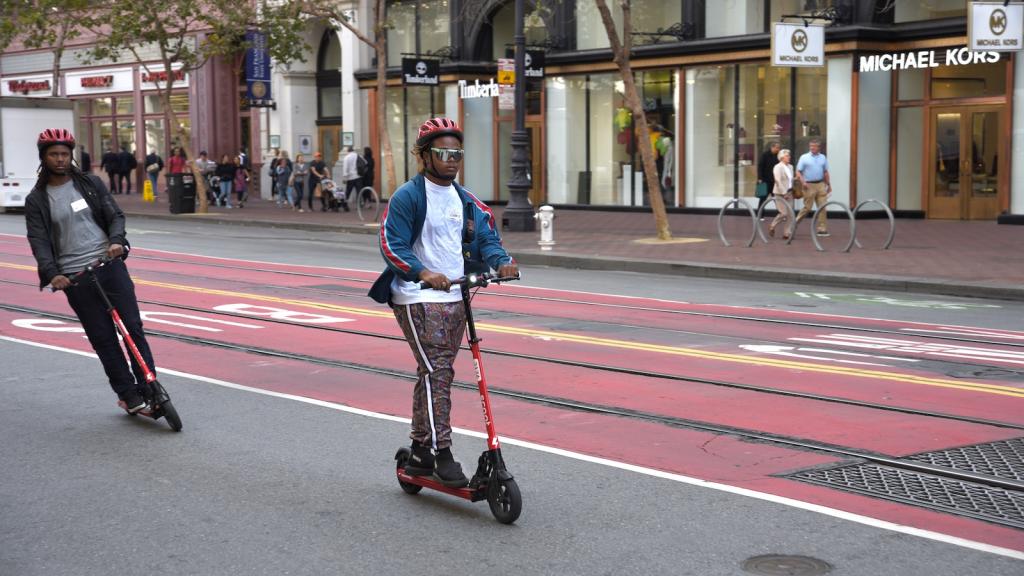 Cyndi Sutter’s trike helped her to feel free again after a brain injury.Photo: Elly BluePeople with disabilities need cars to get around.
Cyndi Sutter’s trike helped her to feel free again after a brain injury.Photo: Elly BluePeople with disabilities need cars to get around.
I can’t count the number of times I’ve been told this. At events, in blog comments, from friends and strangers in conversation. Sometimes I hear it from people who have direct experience with disability. More often the point is produced as part of an argument against making cities bike-friendly.
For many people with disabilities, cars don’t just symbolize independence and freedom, they make those things possible. But this isn’t universally true, and it isn’t always so simple.
Disability advocates often speak of disabilities as a social construct, defined in part by the reality of a missing limb or a head injury, but even more so by the environment and tools available. For instance, in places where glasses are available, being moderately nearsighted isn’t considered a disability; where they’re hard to come by, it’s a whole different story.
Similarly, transportation options, or lack of them, play a major role in shaping what is a disability and what isn’t. If you live in a neighborhood without stores or sidewalks or decent places to walk and you have bad knees, access to a car can indeed be a game changer. But for some people, a bicycle can be the factor that makes life manageable.
Kris Warloe, a semi-retired mathematics teacher in Corvallis, Ore., has been riding a bicycle for transportation since he was 6-years-old. At age 12, he lost his left leg to a crash with a drunk driver. Two years later, he was back on the bike and never stopped. Now 67, he’s still riding about 40 miles a week, as well as swimming daily and skiing through the winter.
He rides a diamond-frame bicycle without special modification. “The hard part is when you put the artificial foot on the pedal,” he said. “You have to keep looking to make sure it’s still on the pedal. It keeps slipping off.” He used to clip the foot into the left pedal. “That worked great until I was pedaling up a steep hill and a gust of wind blew me to the left.”
Cars are all too often the cause of physical disabilities in the first place. Driving is linked to physical inactivity, and likely contributes to the fact that two-thirds of U.S. adults are either overweight or obese. Those who aren’t physically fit are at high risk of diabetes, cancer, and heart disease. Nine percent of non-fatal injuries in car crashes — that’s 286,000 people a year — lead to permanent disability.
There are other kinds of events that change the way you use transportation. Not being able to drive in a world built for cars is the universal reality of aging — and one of the major reasons that old age can often seem like a disability in itself — but can happen suddenly to anyone.
In 2004, Cyndi Sutter survived a traumatic brain injury caused by a rare congenital disorder. Before her injury she had been a daily bike rider. After the long process of learning to walk again, she found that her driver’s license had been canceled and her two-wheeler no longer felt comfortable to ride around Minneapolis.
So in 2006, she went online and bought an upright, adult three-wheeler with a hefty cargo basket. “When I got it, I felt more free,” she said. “I could go to the library and not have to take the bus.” The trike also allowed her to cater events self-sufficiently, carry heavy supplies for volunteer gigs, and bring her dog along in the basket on trips down the city’s famous off-road bike paths.
But despite Minneapolis’s reputation as one of the country’s best cities for bicycling, Sutter found that after her injury car traffic was overwhelming. “I just felt safer on the bus. Even with my helmet and reflective gear,” the streets were too busy, even side streets. “Also, it’s kind of frustrating because my trike doesn’t go as fast as what I’m used to on my road bike.”
Sutter has recently moved to be closer to her family in the small town of Hutchinson, recently named the Best Small Town in Minnesota. It’s a far cry from Minneapolis. “I prefer to live in the city and close to the things that I need,” she told me. She thinks she’ll apply to get her license back in anticipation of winter. But “I’m so glad I’m out here and can ride my two-wheeler again — it’s a plus of living in a town of 14,000.”
Having a bicycle that works for you can make all the difference. There’s a whole movement, Adaptive Cycling, focused on reinventing the bicycle for people who need something other than the classic diamond frame.
Ten years ago on the Fourth of July, Bob Hudecek, a longtime bicycle advocate in northeastern Ohio, was hit by a car while riding. He sustained a spinal cord injury that left him with some feeling but very little movement from the chest down.
“I went eight years without doing much of anything,” he said. Then in 2008 he heard about a chance to try out a handcycle — a recumbent three-wheeler powered by hand-cranked pedals — during a clinic set up by the parks department.
“I didn’t even know those things existed,” he said. “And it was like — wow, this is where I need to be … It’s opened up a lot of doors.”
In the last year, Hudecek began participating in marathons along with other handcyclists. He and his wife have traveled around the country seeking opportunities to ride, from Critical Mass to greenway trails.
Handcycling “really has changed my life in a lot of different ways,” he said. “First and foremost it’s given my wife and me something we can do together and thoroughly enjoy. Second, it’s the health part of it.” And the fun.
I asked Warloe, the 67-year-old in Corvallis, to respond to the argument that promoting bicycling excludes people with disabilities. “As I look around at people my age, they’re either people who do things or they’re twice or three times the size of me,” he said. “It’s a no-brainer. Either you use it or you lose it. Even if you have some disability you should get out there and do something.”
Bicycling clearly isn’t just for the able-bodied (or, as a friend puts it, the temporarily able-bodied). The amazing thing isn’t so much that people with disabilities can ride bicycles, it’s the creativity and against-all-odds resourcefulness so many people show — disabled and otherwise — in getting on a bicycle as a way of taking control of their own mobility and well being, even in the most hostile environments. If anything is going to change our streets, it’s that.



